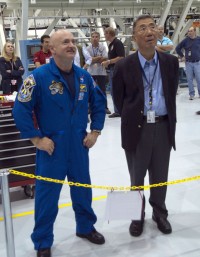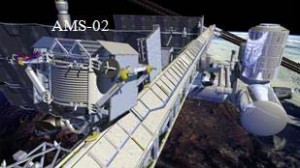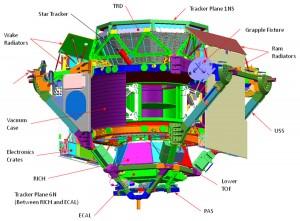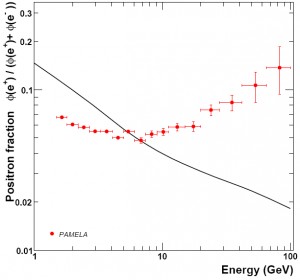A new sophisticated particle physics experiment, the Alpha Magnetic Spectrometer, was launched into space on 16 May 2011. This advanced instrument is the culmination of an almost 20-year effort to design, build and employ an instrument with a goal of performing precision measurements of cosmic ray particles from a platform in space. Using the International Space Station as the platform, it will be able to study the universe by searching for exotic matter like antimatter and dark matter, as well as perform precision measurements of cosmic rays’ composition and flux.
The early history of particle physics came out of cosmic ray studies, well before the first particle accelerators were built. Observations of antimatter, the discovery of the muon, and other early particle physics came from cosmic ray studies and were precursors to the rich field of particle physics that has centred on particle accelerators. It is interesting for those of us developing the next new accelerator, the linear collider, that interesting particle physics is coming from alternate probes, including putting sophisticated devices deep underground and in space. The Alpha Magnetic Spectrometer, AMS, is by far the most ambitious and sophisticated particle physics instrument to be put into space.
A prototype version, called AMS-01, was successfully flown for 10 days on the shuttle Discovery in 1998. It was the first large magnetic spectrometer to operate in space and enabled testing of early versions of many of the components of AMS-02, launched last week to the International Space Station.
The sub-detectors on AMS-01 included a silicon detector that measured the sign and charge of charged particles, a time-of-flight system that measured the velocity of particles and, with the momentum measurements, thereby provided particle identification. The device also had a large veto system to protect the detectors from stray radiation coming at different angles and a Cerenkov counter providing additional particle identification. AMS-01 only flew for 10 days, in contrast to the multi-year observations that are planned for AMS-02. Nevertheless, it provided some interesting results, as well as systems tests prior to the AMS-02 mission. AMS-01 results included measurements of helium, searches for anti-helium and measurements of positrons, a potential probe of new physics.
The centrepiece of AMS-02 is a large spectrometer magnet. Both a superconducting magnet spectrometer and permanent magnet spectrometer were developed for the mission, having the same field configurations and geometric configurations to surround the particle detectors. The superconducting version had the advantage of higher magnetic fields, yielding more precise momentum measurements, but it would have a shorter lifetime and required servicing. In contrast, AMS-02 has been launched with the permanent magnet, enabling a much longer mission. It is built with 6,000 neodymium-iron-boron pieces carefully magnetised and assembled together. This type of magnet was successfully flown on AMS-01. The other detector elements in AMS-02 consist of larger and more sophisticated versions of the sub-detectors tested in AMS-01.

Samuel Ting (right), principal investigator of AMS, with STS-134 mission commander Mark Kelly (left) during a visit of AMS-02 at the Kennedy Space Center in November 2010. Photo courtesy of NASA.
The sensitivity of AMS-02 detector will be well beyond that of any previous instrument put in space to study high-energy cosmic rays. It will make high statistics measurements of the momentum distribution of protons and heavier nuclei up to about 1,000 gigaelectronvolts. Such detailed measurements of the isotopic composition are especially important in giving insight into the scales of propagation times of charged particles in the galaxy, and in turn will provide information on galactic magnetic fields.
The particle separation capability of AMS will also enable it to make measurements of positrons up to approximately 100 GeV. We know how cosmic ray positrons are produced, which is mostly through positron-positron interactions in interstellar space. The goal of the AMS-02 measurements will be to compare the intensity and spectrum measured with the expected production rate. This comparison will help us understand how the energy spectrum is deformed by diffusion or radiative energy losses in the galaxy.
Excesses in the antiparticle (e.g., positrons and antiprotons) spectra could result from dark matter particle annihilations. Indications of an excess were first reported 15 years ago by HEAT, a cosmic ray balloon experiment, and more recently by PAMELA, an Italian experiment in space on a Russian satellite. The precision measurements from AMS-02 should resolve whether these hints are real.
Sam Ting, MIT and CERN, has been the leader and driving force behind AMS from inception. I have personally known and been a friend of Sam’s for years and, in fact, we share the same birth date and were born only a few hundred kilometres apart. I would characterise Sam’s physics career as one where he has consistently uncovered new important particle physics through making precision measurements. Ting discovered the J/ψ particle in 1974, for which he shared the Nobel Prize with Burt Richter. The design of AMS exemplifies this same careful approach, and when Ting has been asked about the goals of this mission, he has replied, “the most exciting objective of AMS is to probe the unknown, to search for phenomena which exist in nature that we have not yet imagined nor had the tools to discover.”
I heartily congratulate Sam and collaborators for developing AMS and on the successful launch. I eagerly look forward to the physics results they will produce.





Recent Comments